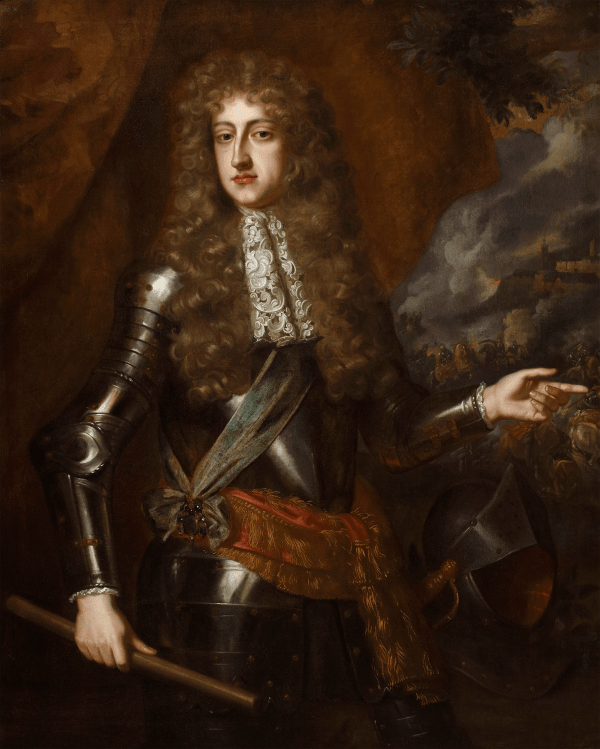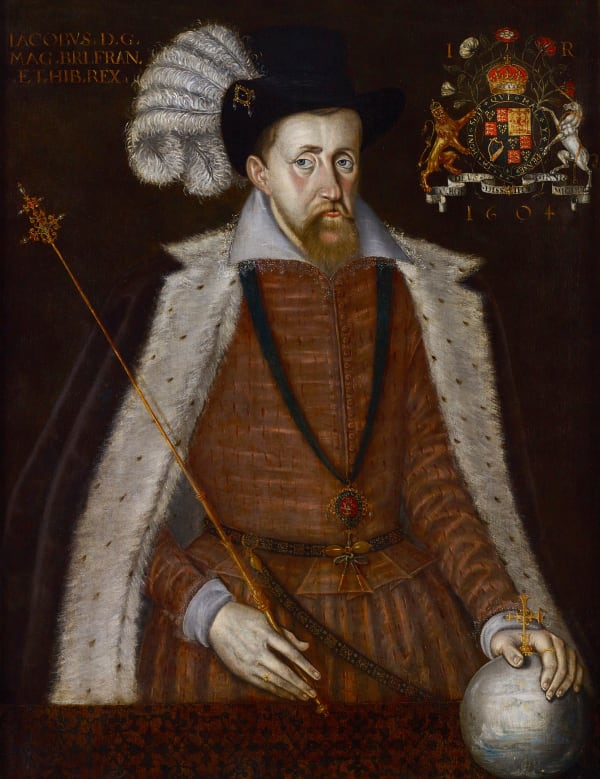
Studio of Sir Godfrey Kneller Bt.
Portrait of Charles II (1630-85), seated wearing the robes of the Garter, late 17th century
Oil on canvas
39 ¼ x 24 ¼ in. (99.6 x 61.5 cm)
Philip Mould & Co.
%3Cdiv%20class%3D%22artist%22%3EStudio%20of%20Sir%20Godfrey%20Kneller%20Bt.%3C/div%3E%3Cdiv%20class%3D%22title_and_year%22%3E%3Cspan%20class%3D%22title_and_year_title%22%3EPortrait%20of%20Charles%20II%20%281630-85%29%2C%20seated%20wearing%20the%20robes%20of%20the%20Garter%3C/span%3E%2C%20%3Cspan%20class%3D%22title_and_year_year%22%3Elate%2017th%20century%3C/span%3E%3C/div%3E%3Cdiv%20class%3D%22medium%22%3EOil%20on%20canvas%3C/div%3E%3Cdiv%20class%3D%22dimensions%22%3E39%20%C2%BC%20x%2024%20%C2%BC%20in.%20%2899.6%20x%2061.5%20cm%29%3C/div%3E
To view all current artworks for sale visit philipmould.com
The present work is a reduced-scale studio version of Kneller’s portrait of King Charles II painted in 1685 [Liverpool, Walker Art Gallery]. The king is shown seated wearing the robes of the Order of the Garter, the highest order of chivalry within the kingdom, and is positioned beside the royal orb and crown – all symbolic attributes of his position as head of state.
Following the Restoration in 1660 the arts in England gained further momentum and Charles, like his father King Charles I, wasted little time patronising the greatest artists of the day; just two weeks after his return, for example, he visited the studio of limner Samuel Cooper (1609-72) ‘[…] of whose fame he had so much heard abroad […]’[1], where he sat for a portrait. Where the king led, his court followed and some of the most exciting and celebrated English portraits were painted during this period, with the aristocracy and actresses alike flocking to the studios of great painters like Sir Peter Lely (1618-80), Jacob Huysmans (c.1630-96) and later, Sir Godfrey Kneller.
Kneller arrived in England in 1676 and had, by this stage, already built a considerable reputation in the Low Countries as a history painter, training with Rembrandt van Rijn (1606-69) in Amsterdam and studying the works of Titian (1488/90-1576) in Italy. Within two years of his arrival Kneller had secured a sitting with the king via James Scott, 1st Duke of Monmouth (1649-85), after which his ‘reputation increased so that most nobleman & Ladies would have their picture done by him’.[2] Kneller now worked within the highest echelons of society and his confidence at this stage is best reflected in his ambitious portrait of Mohammed Ohadu, the Moroccan Ambassador, on horseback [Chiswick House]. The following year Kneller painted this portrait-type of Charles, which was probably the last portrait of the king painted by Kneller prior to Charles’ death that same year.
The death of his royal patron did little to stunt the ascent of Kneller’s career and in 1689, following the Glorious Revolution and the accession of William III (1650-1702) and Mary II (1662-94) to the throne, Kneller, and competitor Riley, were appointed Principal Painters to the new monarchs. One of Kneller’s most significant commissions from this period was The Hampton Court Beauties (started in 1689), a series of eight portraits depicting the eight most beautiful members of Mary II’s court. The idea for this commission perhaps stemmed from Lely’s series now known as The Windsor Beauties, painted in the mid-late 1660s, and would thus have been an irresistible opportunity for Kneller to flaunt his talents in parallel to his predecessor at the English court.
Kneller maintained his position following the accession of Queen Anne (1665-1714) to the throne and his studio, which was now a well-oiled operation, and was kept busy with the various courtiers and commanders, many of whom had gained prominence during the War of the Spanish Succession (1701-14). In 1715, following the accession of George I (1660-1727), Kneller was created a baronet – a pertinent reflection of the position he now held in society, and an honour not repeated until 1896, when the painter Frederic Leighton (1830-96) was awarded a peerage. Kneller died in October 1723 and was buried at St Mary’s Church, Twickenham.
[1] Letter from John Aubrey to Thomas Hobbes, quoted in Daphne Foskett, Samuel Cooper (1609-1672), (London, 1974), p.45.
[2] ‘Vertue Notebooks Volume 1’, in The Walpole Society, Vol. 18, 1929-30, (Oxford, 1930), p.28.
The present work is a reduced-scale studio version of Kneller’s portrait of King Charles II painted in 1685 [Liverpool, Walker Art Gallery]. The king is shown seated wearing the robes of the Order of the Garter, the highest order of chivalry within the kingdom, and is positioned beside the royal orb and crown – all symbolic attributes of his position as head of state.
Following the Restoration in 1660 the arts in England gained further momentum and Charles, like his father King Charles I, wasted little time patronising the greatest artists of the day; just two weeks after his return, for example, he visited the studio of limner Samuel Cooper (1609-72) ‘[…] of whose fame he had so much heard abroad […]’[1], where he sat for a portrait. Where the king led, his court followed and some of the most exciting and celebrated English portraits were painted during this period, with the aristocracy and actresses alike flocking to the studios of great painters like Sir Peter Lely (1618-80), Jacob Huysmans (c.1630-96) and later, Sir Godfrey Kneller.
Kneller arrived in England in 1676 and had, by this stage, already built a considerable reputation in the Low Countries as a history painter, training with Rembrandt van Rijn (1606-69) in Amsterdam and studying the works of Titian (1488/90-1576) in Italy. Within two years of his arrival Kneller had secured a sitting with the king via James Scott, 1st Duke of Monmouth (1649-85), after which his ‘reputation increased so that most nobleman & Ladies would have their picture done by him’.[2] Kneller now worked within the highest echelons of society and his confidence at this stage is best reflected in his ambitious portrait of Mohammed Ohadu, the Moroccan Ambassador, on horseback [Chiswick House]. The following year Kneller painted this portrait-type of Charles, which was probably the last portrait of the king painted by Kneller prior to Charles’ death that same year.
The death of his royal patron did little to stunt the ascent of Kneller’s career and in 1689, following the Glorious Revolution and the accession of William III (1650-1702) and Mary II (1662-94) to the throne, Kneller, and competitor Riley, were appointed Principal Painters to the new monarchs. One of Kneller’s most significant commissions from this period was The Hampton Court Beauties (started in 1689), a series of eight portraits depicting the eight most beautiful members of Mary II’s court. The idea for this commission perhaps stemmed from Lely’s series now known as The Windsor Beauties, painted in the mid-late 1660s, and would thus have been an irresistible opportunity for Kneller to flaunt his talents in parallel to his predecessor at the English court.
Kneller maintained his position following the accession of Queen Anne (1665-1714) to the throne and his studio, which was now a well-oiled operation, and was kept busy with the various courtiers and commanders, many of whom had gained prominence during the War of the Spanish Succession (1701-14). In 1715, following the accession of George I (1660-1727), Kneller was created a baronet – a pertinent reflection of the position he now held in society, and an honour not repeated until 1896, when the painter Frederic Leighton (1830-96) was awarded a peerage. Kneller died in October 1723 and was buried at St Mary’s Church, Twickenham.
[1] Letter from John Aubrey to Thomas Hobbes, quoted in Daphne Foskett, Samuel Cooper (1609-1672), (London, 1974), p.45.
[2] ‘Vertue Notebooks Volume 1’, in The Walpole Society, Vol. 18, 1929-30, (Oxford, 1930), p.28.
Provenance
Private Collection USA
Share
- X
- Tumblr
1
of
12
Related artworks
-
 Willem WissingPrince George of Denmark (1653-1708), c. 1684
Willem WissingPrince George of Denmark (1653-1708), c. 1684 -
 English SchoolPortrait of Charles I (1600-1649), wearing the robes of the Order of the Garter, c. 1633-40
English SchoolPortrait of Charles I (1600-1649), wearing the robes of the Order of the Garter, c. 1633-40 -
 Studio of Sir Peter LelyPortrait of King Charles II (1630-85), wearing the robes of the Sovereign of the Order of the Garter, c. 1675-85
Studio of Sir Peter LelyPortrait of King Charles II (1630-85), wearing the robes of the Sovereign of the Order of the Garter, c. 1675-85 -
 English SchoolKing James VI & I (1566-1625), 1604
English SchoolKing James VI & I (1566-1625), 1604



